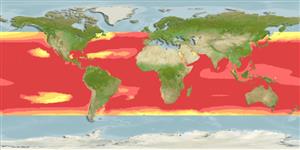Environment: milieu / climate zone / depth range / distribution range
البيئة
بحري; محيطية (Ref. 51243); نطاق العمق 0 - 1500 m (Ref. 117020), usually 0 - 500 m (Ref. 117020). Subtropical; 13°C - 29°C (Ref. 168); 52°N - 48°S, 180°W - 180°E
Atlantic, Indian and Pacific: in tropical and subtropical waters. Absent in the Mediterranean. Highly migratory species.
Length at first maturity / الحجم / وزن / العمر
Maturity: Lm 112.5, range 100 - 125 cm
Max length : 250 cm TL ذكر/ مختلط الجنس; (Ref. 27000); common length : 180 cm FL ذكر/ مختلط الجنس; (Ref. 168); أعلا وزن تم نشرة: 210.0 kg (Ref. 9987); العمر: 11 سنين (Ref. 30326)
الأشواك الظهرية (المجموع) : 13 - 14; الأشعة الظهرية الناعمة (المجموع) : 14 - 15; شوكة شرجية: 0; أشعه شرجية لينه: 14; فقرات: 39. This large species is distinguished by the following characters: robust, fusiform body, slightly compressed from side to side; total gill rakers on first gill arch 23-31; dorsal fins separated only by a narrow interspace, the second followed by 8-10 finlets; anal fin followed by 7-10 finlets; pectoral fins moderately long (22 to 31% of fork length) in large specimens (over 110 cm FL), but very long (as long as in Thunnus alalunga) in smaller specimens; 2 flaps (interpelvic process) between pelvic fins; very small scales on body; corselet of larger and thicker scales developed, but not very distinct; caudal peduncle very slender, with a strong lateral keel between 2 smaller keels; ventral surface of liver striated; swimbladder present. Colour of back metallic dark blue, lower sides and belly whitish; a lateral iridescent blue band runs along sides in live specimens; first dorsal fin deep yellow, second dorsal and anal fins light yellow, finlets bright yellow edged with black (Ref. 9684).
Occur in areas where water temperatures range from 13°-29°C, but the optimum is between 17° and 22°C. Variation in occurrence is closely related to seasonal and climatic changes in surface temperature and thermocline. Juveniles and small adults school at the surface in mono-species groups or mixed with other tunas, may be associated with floating objects. Adults stay in deeper waters (Ref. 5377). Eggs and larvae are pelagic (Ref. 6390). Feed on a wide variety of fishes, cephalopods and crustaceans during the day and at night (Ref. 9340). Meat is highly prized and processed into sashimi in Japan. Marketed mainly canned or frozen (Ref. 9684), but also sold fresh (Ref. 9340).
Are multiple spawners that may spawn every 1 or 2 days over several months (Ref. 30330). They spawn over periods of the full moon (Ref. 6390). Spawn throughout the year in tropical waters (Ref. 6390).
Collette, B.B. and C.E. Nauen, 1983. FAO Species Catalogue. Vol. 2. Scombrids of the world. An annotated and illustrated catalogue of tunas, mackerels, bonitos and related species known to date. Rome: FAO. FAO Fish. Synop. 125(2):137 p. (Ref. 168)
IUCN Red List Status (Ref. 130435)
استخدامات بشرية
مصائد: ذو قيمة تاجرية عالية; لعبة سمكه: نعم
أدوات
تقارير خاصة
Download XML
مصادر علي الأنترنت
Estimates based on models
Preferred temperature (Ref.
123201): 16.8 - 28.6, mean 26.6 °C (based on 3638 cells).
Phylogenetic diversity index (Ref.
82804): PD
50 = 0.5039 [Uniqueness, from 0.5 = low to 2.0 = high].
Bayesian length-weight: a=0.01318 (0.01039 - 0.01673), b=3.03 (2.99 - 3.07), in cm total length, based on LWR estimates for this species (Ref.
93245).
مستوى غذائي (Ref.
69278): 4.5 ±0.0 se; based on diet studies.
Generation time: 6.6 (4.4 - 10.4) years. Estimated as median ln(3)/K based on 12
growth studies.
المرونه (Ref.
120179): وسيط, الحد الزمني الأدني لتضاعف عدد أفراد المجتمع 1.4-4.4 سنة (K=0.11-0.23; tm=3; tmax=11; Fec=2 million).
Prior r = 0.52, 95% CL = 0.34 - 0.77, Based on 10 full stock assessments.
Fishing Vulnerability (Ref.
59153): High vulnerability (56 of 100).
Climate Vulnerability (Ref.
125649): Moderate to high vulnerability (47 of 100).
Nutrients (Ref.
124155): Calcium = 22.1 [12.0, 42.2] mg/100g; Iron = 2.65 [1.06, 6.93] mg/100g; Protein = 24 [23, 25] %; Omega3 = 0.453 [0.273, 0.754] g/100g; Selenium = 54.7 [17.4, 171.5] μg/100g; VitaminA = 19.6 [2.7, 180.1] μg/100g; Zinc = 0.278 [0.153, 0.561] mg/100g (wet weight);
